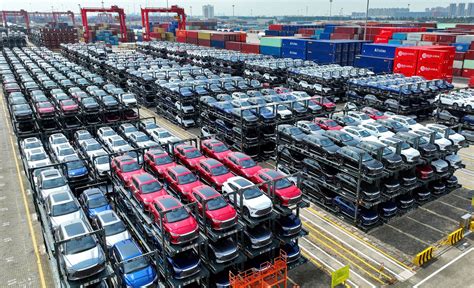
Brazil is grappling with a surge of affordable electric vehicles (EVs) from China, igniting trade friction and prompting concerns about the future of the nation’s automotive industry.
The influx of cheaper Chinese EVs, led by companies like BYD and GWM (Great Wall Motor), is rapidly gaining market share in Brazil, forcing domestic manufacturers and traditional automakers to respond. This surge has sparked worries about job losses, the competitiveness of local industry, and the potential need for government intervention to level the playing field. While Brazilian consumers benefit from more accessible EV options, the long-term economic consequences are raising alarms within the government and automotive sector. “The invasion of Chinese cars is a reality,” said Cassio Pagliarini, a consultant at Bright Consulting. “If Brazil does not take protective measures, the local industry will be cannibalized.”
The Chinese EV Onslaught
Chinese automakers have identified Brazil as a key market for expansion, capitalizing on the growing global demand for electric vehicles and the increasing consumer interest in sustainable transportation. BYD, for example, is investing heavily in Brazil, establishing a manufacturing hub in Bahia, a state in northeastern Brazil. This complex will encompass production facilities for electric buses, trucks, and passenger cars, with an anticipated production capacity of 150,000 vehicles annually in the initial phase, eventually scaling up to 300,000. “We will build a large complex in Bahia, with a capacity that can reach 300,000 vehicles,” said Alexandre Baldy, a special advisor to BYD in Brazil.
GWM is also making significant inroads, having acquired a former Mercedes-Benz factory in Iracemápolis, São Paulo. They have already launched hybrid vehicles in the Brazilian market and are poised to introduce fully electric models. Their strategy involves offering competitive pricing and advanced technology to attract Brazilian consumers.
The appeal of Chinese EVs lies primarily in their affordability. Backed by substantial government subsidies in China and benefiting from economies of scale, these vehicles are often priced significantly lower than comparable models from established automakers. This price advantage is particularly attractive in Brazil, where cost sensitivity is a major factor in purchasing decisions.
However, this price competitiveness has raised concerns about unfair trade practices. Brazilian manufacturers argue that the Chinese EVs are artificially cheap due to government support, creating an uneven playing field that disadvantages local companies. The Brazilian government is under pressure to investigate these claims and consider measures to protect domestic industry.
Impact on the Brazilian Automotive Industry
The arrival of Chinese EVs poses a direct threat to the existing Brazilian automotive industry, which has long been dominated by foreign brands like Fiat, Volkswagen, General Motors, and Ford. These companies have manufacturing facilities in Brazil and employ a significant number of workers. The increased competition from Chinese EVs could lead to reduced sales, plant closures, and job losses.
Brazilian automakers are scrambling to adapt to the changing landscape. Some are accelerating their own EV development programs, while others are exploring partnerships with Chinese companies. Stellantis, for example, which owns brands like Fiat and Peugeot, has announced plans to invest heavily in electrification in Brazil. Volkswagen is also ramping up its EV offerings, with plans to introduce new electric models in the coming years.
However, catching up with the Chinese in terms of price competitiveness and technological advancement is a significant challenge. Brazilian automakers face higher production costs, including labor and raw materials, and they lack the same level of government support as their Chinese counterparts.
The potential for job losses is a major concern for the Brazilian government. The automotive industry is a significant employer in Brazil, and any decline in the sector could have a ripple effect throughout the economy. The government is exploring various options to mitigate the impact, including providing incentives for local EV production, imposing tariffs on imported EVs, and promoting the development of a local EV supply chain.
Government Response and Policy Options
The Brazilian government is walking a tightrope, trying to balance the benefits of affordable EVs for consumers with the need to protect domestic industry. Several policy options are under consideration, each with its own set of advantages and disadvantages.
- Tariffs on Imported EVs: Imposing tariffs on imported Chinese EVs would make them more expensive, reducing their price advantage and protecting local manufacturers. However, this could also lead to retaliatory measures from China, which is a major trading partner of Brazil. Moreover, higher prices for EVs could slow down the transition to electric mobility in Brazil.
- Incentives for Local EV Production: Providing incentives for local EV production, such as tax breaks and subsidies, would encourage automakers to invest in Brazil and create jobs. This would also help to develop a local EV supply chain, reducing reliance on imports. However, this approach could be costly for the government and may not be sufficient to offset the price advantage of Chinese EVs.
- Stricter Safety and Environmental Standards: Implementing stricter safety and environmental standards for EVs could make it more difficult for Chinese manufacturers to sell their vehicles in Brazil. However, this could also be seen as a protectionist measure and could violate international trade agreements.
- Promoting a Local EV Supply Chain: Supporting the development of a local EV supply chain, including battery production and charging infrastructure, would reduce reliance on imports and create jobs. This would also make Brazil more competitive in the global EV market. However, this is a long-term project that requires significant investment and coordination.
- Negotiating Trade Agreements: Engaging in negotiations with China to address concerns about unfair trade practices could lead to a more level playing field. This could involve seeking commitments from China to reduce subsidies for EV production or to open up its market to Brazilian products.
“If Brazil does not take protective measures, the local industry will be cannibalized,” warns Cassio Pagliarini.
Geopolitical Implications
The EV trade dispute between Brazil and China has broader geopolitical implications. It reflects the growing competition between the two countries in the global economy, as well as the increasing importance of electric vehicles in the transition to a low-carbon future.
China has emerged as a global leader in EV production, thanks to massive government investment and a large domestic market. Brazil, on the other hand, has significant natural resources, including lithium and nickel, which are essential for EV battery production. The two countries could potentially cooperate in the EV sector, with Brazil supplying raw materials and China providing manufacturing expertise.
However, the trade dispute over Chinese EVs could undermine this potential cooperation. It highlights the challenges of balancing economic interests with geopolitical considerations. The Brazilian government will need to carefully navigate this complex landscape to protect its domestic industry while maintaining good relations with China.
Consumer Perspective
While the influx of Chinese EVs presents challenges for the Brazilian automotive industry, it also offers benefits for consumers. Cheaper EVs make electric mobility more accessible to a wider range of people, helping to reduce air pollution and greenhouse gas emissions.
Brazilian consumers are increasingly interested in electric vehicles, driven by concerns about environmental sustainability and rising fuel prices. However, the high cost of EVs has been a major barrier to adoption. The arrival of cheaper Chinese EVs is helping to overcome this barrier, making electric mobility a more realistic option for many Brazilians.
The increased competition in the EV market is also likely to lead to improvements in technology and features. Automakers will be forced to innovate and offer better products to attract consumers. This will ultimately benefit Brazilian consumers, who will have access to a wider range of high-quality EVs at affordable prices.
Future Outlook
The future of the Brazilian automotive industry is uncertain. The industry is facing a major transformation, driven by the shift to electric vehicles and the increasing competition from Chinese automakers.
The Brazilian government will play a crucial role in shaping the future of the industry. Its policy decisions will determine whether Brazil can maintain a viable automotive sector or whether it will become overly reliant on imports.
Brazilian automakers will need to adapt quickly to the changing landscape. They will need to invest in EV technology, improve their cost competitiveness, and develop innovative products to attract consumers.
The outcome of this transformation will have a significant impact on the Brazilian economy, its environment, and its relationship with China. It is a complex and multifaceted challenge that requires careful consideration and strategic planning.
The BYD Factor
BYD’s investment in a manufacturing hub in Bahia represents a turning point for the Brazilian EV market. This facility will not only produce electric vehicles but also create jobs and stimulate the local economy. BYD’s presence in Brazil is likely to attract other EV-related companies, further developing the local EV ecosystem.
BYD’s success in China has been built on a combination of technological innovation, aggressive pricing, and strong government support. The company is now applying this formula to Brazil, with the aim of becoming a major player in the Brazilian EV market.
BYD’s arrival is putting pressure on traditional automakers to accelerate their EV development plans and to improve their cost competitiveness. It is also forcing the Brazilian government to consider new policies to support the local EV industry.
The Great Wall Motor (GWM) Strategy
GWM’s acquisition of the former Mercedes-Benz factory in Iracemápolis is another significant development in the Brazilian EV market. This factory provides GWM with a ready-made production facility, allowing it to quickly ramp up production of electric and hybrid vehicles.
GWM is focusing on the hybrid market initially, before introducing fully electric models. This strategy allows the company to build brand awareness and to test the waters before making a full commitment to EVs.
GWM’s hybrid vehicles are priced competitively, making them an attractive option for Brazilian consumers who are looking for a more fuel-efficient alternative to traditional gasoline-powered cars.
The Role of Ethanol
Brazil has a unique advantage in the field of sustainable transportation: ethanol. Ethanol is a biofuel made from sugarcane, and it is widely used in Brazil as a gasoline substitute.
Ethanol-powered vehicles are already a significant part of the Brazilian car market. However, the rise of electric vehicles poses a challenge to the ethanol industry. If EVs become widespread, demand for ethanol could decline, potentially harming the sugarcane industry and the millions of Brazilians who depend on it for their livelihoods.
The Brazilian government is exploring ways to integrate ethanol into the EV ecosystem. One option is to develop hybrid vehicles that can run on both ethanol and electricity. This would allow consumers to benefit from the environmental advantages of both technologies.
The Need for Infrastructure
The widespread adoption of electric vehicles requires a robust charging infrastructure. Brazil currently lacks a sufficient number of charging stations to support a large EV fleet.
The Brazilian government is working to address this issue by providing incentives for the construction of new charging stations. Automakers are also investing in charging infrastructure.
However, much more needs to be done to ensure that Brazil has a comprehensive charging network that can support the growth of the EV market.
The Importance of Public Awareness
Public awareness is crucial for the success of the EV market. Many Brazilians are still unfamiliar with electric vehicles and their benefits.
The Brazilian government and automakers need to educate the public about EVs and to promote their adoption. This can be done through advertising campaigns, educational programs, and public demonstrations.
Increased public awareness will help to overcome the barriers to EV adoption and to accelerate the transition to electric mobility in Brazil.
The Challenge of Battery Production
The production of EV batteries is a critical component of the EV supply chain. Brazil currently does not have a large-scale battery manufacturing industry.
The Brazilian government is exploring ways to attract battery manufacturers to Brazil. This would reduce reliance on imports and create jobs.
However, attracting battery manufacturers requires a stable investment climate, a skilled workforce, and access to raw materials.
The Impact on the Environment
The transition to electric vehicles has the potential to significantly reduce air pollution and greenhouse gas emissions in Brazil. EVs produce no tailpipe emissions, which can improve air quality in urban areas.
However, the environmental benefits of EVs depend on the source of electricity used to charge them. If EVs are charged with electricity generated from fossil fuels, the environmental benefits will be limited.
Brazil has a relatively clean electricity grid, thanks to its reliance on hydropower and other renewable sources. This means that EVs in Brazil have the potential to significantly reduce greenhouse gas emissions.
Conclusion
The influx of Chinese EVs is transforming the Brazilian automotive industry. While it presents challenges for domestic manufacturers, it also offers opportunities for consumers and for the environment.
The Brazilian government will need to carefully navigate this complex landscape to ensure that Brazil can benefit from the transition to electric mobility while protecting its domestic industry.
The future of the Brazilian automotive industry will depend on the choices that are made today. By embracing innovation, investing in infrastructure, and fostering a supportive policy environment, Brazil can position itself as a leader in the global EV market. The next few years will be critical in determining whether Brazil can successfully navigate this transformation and emerge as a competitive player in the new era of electric mobility. The balancing act between welcoming affordable technology and safeguarding local industries will define Brazil’s automotive future.
Frequently Asked Questions (FAQ)
1. Why are Chinese EVs so much cheaper than other EVs in Brazil?
Chinese EVs often have a lower price point due to a combination of factors. These include significant government subsidies provided to EV manufacturers in China, enabling them to achieve economies of scale and reduce production costs. Additionally, China’s well-established supply chain for EV components, particularly batteries, contributes to lower manufacturing expenses. Finally, some critics argue that these prices may be artificially low due to unfair trade practices, leading to concerns about market distortion.
2. What is the Brazilian government doing to address the influx of Chinese EVs?
The Brazilian government is currently evaluating several policy options to address the influx of Chinese EVs. These include the potential implementation of tariffs on imported EVs to reduce their price advantage, incentives for local EV production to encourage domestic manufacturing and job creation, stricter safety and environmental standards to ensure imported EVs meet Brazilian regulations, and promoting the development of a local EV supply chain to reduce reliance on foreign components. They are also considering negotiating trade agreements with China to address concerns about unfair trade practices.
3. How will the arrival of Chinese EVs affect Brazilian consumers?
The arrival of Chinese EVs presents both potential benefits and drawbacks for Brazilian consumers. On the positive side, cheaper EVs make electric mobility more accessible to a wider range of people, potentially leading to reduced air pollution and greenhouse gas emissions. Increased competition in the EV market could also drive innovation and improve the technology and features offered in EVs. However, if domestic automakers struggle to compete, consumers might have fewer choices in the long run, and the potential impact on employment could indirectly affect consumer spending power.
4. What are the long-term implications for the Brazilian automotive industry?
The long-term implications for the Brazilian automotive industry are significant and uncertain. The industry faces a major transformation driven by the shift to electric vehicles and the increasing competition from Chinese automakers. To survive and thrive, Brazilian automakers will need to adapt quickly by investing in EV technology, improving their cost competitiveness, and developing innovative products. The industry’s ability to adapt, coupled with the government’s policy decisions, will determine whether Brazil can maintain a viable automotive sector or become overly reliant on imports.
5. What role does ethanol play in Brazil’s automotive future, given the rise of EVs?
Ethanol, a biofuel widely used in Brazil, has historically played a significant role in the country’s automotive sector. However, the rise of EVs poses a challenge to the ethanol industry. The Brazilian government is exploring ways to integrate ethanol into the EV ecosystem, such as developing hybrid vehicles that can run on both ethanol and electricity. This approach could allow Brazil to leverage its existing ethanol infrastructure and maintain a diversified energy portfolio while transitioning towards more sustainable transportation options. The future likely involves a mix of EVs and ethanol-powered vehicles, with the exact balance depending on technological advancements and government policies.









